I am in Sydney for five days. The weather is perfect (apologies to those of you who are suffering the vicissitudes of winter). The city is urban, attractive and surrounded by water. Ferries and pleasure craft are everywhere. There is no doubt that for me, the standout is the Sydney Opera House, gorgeous and innovative architecturally, situated on a promontory at the edge of Sydney Harbor that was originally a meeting place for indigenous people. While I have seen photos of this iconic building over the years, viewing it in person at different times of the day in changing light, is mesmerizing.

Designed by Danish architect Jorn Utzon in the 1950s after an international competition, the plans were considered by some too forward-thinking and were initially discarded, only to be retrieved later due to promises of a three year construction schedule at a relatively modest $7 million. Alas, as with so many projects, there was insufficient consideration given to engineering issues which caused the design to change continually. The bottom line is that it took ten thousand workers fifteen years at a cost of $107 million to complete the ten sails made up of one million self-cleaning ceramic tiles. Finally opening in 1973, the structure has six different theaters, is now a UNESCO World Heritage site and is almost universally acclaimed as one of the most stunning and creative buildings anywhere.

Adjacent to and nearly surrounding the Opera House is the Royal Botanical Gardens, an Eden between the tall city buildings and the Harbor. Having a tropical climate, Sydney’s foliage grows bounteously and the trees, in particular, are commanding and capacious.



For the last portion of my Australian journey, I fly to Melbourne from where I am driven three hours to The Great Otway National Park in the state of Victoria. There I meet up with four other hikers (three Aussies and a Brit) and two guides, for a four day hike called The Twelve Apostles Walk.
Before we begin the Walk, we’re given gators. I think we must be in for wet weather, but no, the gators are to protect ankles from snake bites as all snakes in the area are venomous! We’re told to watch out for jumping ants as they have a nasty sting and for a variety of spiders that are also poisonous. I begin to have second thoughts about this hike.
The trail hugs the ocean coast for a distance of one hundred km. We walk just under fifty of them, the path undulating through bushes and trees shaped by salt air and wind.

I keep my eyes on the roiling, foamy sea below, endlessly stretching wide and wild, finally dropping down beside it to tramp across the soft, white sand.

We see kangaroos and wallabies by the road, on the path, on the beach.

Clouds, dark and darker, fill the sky, the sun casting its rays randomly on the water; the crack of the breaking waves in the distance a constant companion.

And on the final day of the Walk, we reach the Twelve Apostles, although there aren’t twelve and never have been! Originally, there were nine that were called Sow and Pigs by the local farmers. Not being all that catchy, it was changed in the mid-twentieth century to its current name, apparently a good marketing move as it then became a popular tourist destination. There are now seven limestone stacks (two collapsed due to erosion) and they are quite a sight from the trail, the beach, and most spectacularly, from a helicopter.

I happily conclude my first time in Australia having visited with old friends, gained some new ones, and walked some dramatic landscapes.



3 Comments
Beautiful writing, as always. 🙂
I enjoyed very much, reading it.
Greetings from Sarajevo.
Hi Adele,
Great photos and information, as always.
xxoo,Anne
Any snake bites? Love the coastline, so dramatic. Sue